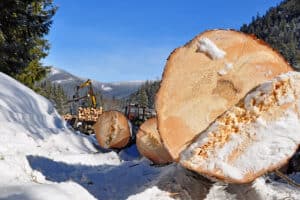The general consensus at the 7th Annual Timberland Investment Summit held in Vancouver, BC, at the end of June was that new single-family housing starts would recover to about 900,000 units a year within the next two to four years. That’s about half of the 2006 high, but it’s about twice 2010’s current annualized new-start rate. Nine hundred thousand new housing starts, not 1.5 or 2 million, might be considered the mid-term future’s expected norm.
No one forecast second-home starts and timberland sales.
Home construction is projected to boost lumber and timber prices, which, in turn, would strengthen timberland prices. But whether the turnaround comes in two years, four, or six is anybody’s jump ball.
Put differently, timberland prices should gain last in line, lagging stumpage prices, which will lag lumber prices, which will lag improved housing prices. On the other hand, timberland prices have not fallen as much as housing prices, so less loss has to be made up.
Housing starts are not correlated with timber (stumpage) prices, observed Jack Lutz, a long-time market analyst with the Forest Research Group. Timber prices lag housing starts by 12 to 24 months, and they tend to regress to their mean over time, he said.
Clark Binkley, managing director of International Forestry Investment Advisors, added that “real timber prices can’t go up over time.” Nominal prices, unadjusted for inflation, will, however.
Lutz believes that timber prices won’t pick up for two years, because trees have been stored on the stump for the last three years rather than sold into a down market. This will make for a price-suppressing supply situation when demand does pick up.
Timberland prices have not been correlated with timber prices or housing starts historically. Timberland prices have correlated with stumpage (timber) prices over the very long term, not the short-term.
Recent timberland prices have been driven higher and then supported by imputed Higher-and-Better-Use values associated with second homes and recreation even as both housing starts and stumpage prices fell. One question is whether or not HBU valuation fundamentally and perpetually shifts timberland prices up going forward, or, alternatively, whether HBU is more of a bubble.
From an investor’s point of view, HBU “value” is a much trickier (and softer) asset than merchantable timber. Thirty years ago, it was not that hard to find timberland priced with 70 percent of more of the acquisition cost found in the merch. Today, 70 percent of timberland cost is typically purported to be in the bare dirt, and, perhaps half of that, in inferred HBU value. Buying a 70:30, land-to-timber tract increases investment risk and makes 10 to 20 percent down-payment financing hard to arrange.
The market for timberland is somewhat distorted in my opinion. It’s not reacting in price terms to supply-and-demand factors, because much of it is owned or controlled by investors like pension funds, endowments, hedge funds and private-equity firms that can wait out a down market and not lower their price to get a sale.
Many individual timberland owners also appear to have the ability to carry their investments for the next few years, rather than sell at a 2000 price.
The new-start housing forecasters see a huge pent up demand for stick-built homes. They argue, maybe assume, that higher employment rates will drive these sales.
I’m moderately skeptical of the link between employment and new-start housing in our current times.
People buy housing when their current income and long-term prospects are sufficient to afford it; we’ve seen what happens when they can’t afford it. Employment rates can rise without income capability rising. Income, not employment, will drive new housing. A fully-employed Nation of low-wage McFlippers will not be buying houses.
It’s plausible to me that our economy has permanently been reset by the irretrievable loss of much of our high-wage manufacturing base overseas. In turn, that loss will reduce high-wage public-service employment sooner or later. This will leave a smaller and poorer middle class. America’s economy will continue to grow, but at a slower rate than in the past. Our expected economic-growth norms will be lower, even as our population grows.
A housing-start recovery might occur in the shape of a hockey stick, but it’s just as arguable that the mid-term future looks like protracted 7-9 percent unemployment (with real unemployment at 15 percent of more) and real income stagnating or declining in the middle-income and blue-collar sectors.
Demand for timber will grow moderately whether you’re an optimist or a skeptic as population grows. Timberland investments should work over a long term, i.e., more than 10 years, if bought properly.
But timberland investors should no longer expect annual returns in the 9-to-15 percent range as long as unemployment is high, income is chancy and our economy is establishing new norms that are lower than those they’re replacing.
The consensus now seems to have been reset at 6-to-7 percent nominal annual returns on large timberland investments, held for a number of years.
If return expectations are cut in half, what change might we expect in timberland prices?
The next timberland investment summit will be held in New York City, October 27-October 29, 2010. LANDTHINK is a media sponsor of this event.
This content may not be used or reproduced in any manner whatsoever, in part or in whole, without written permission of LANDTHINK. Use of this content without permission is a violation of federal copyright law. The articles, posts, comments, opinions and information provided by LANDTHINK are for informational and research purposes only and DOES NOT substitute or coincide with the advice of an attorney, accountant, real estate broker or any other licensed real estate professional. LANDTHINK strongly advises visitors and readers to seek their own professional guidance and advice related to buying, investing in or selling real estate.










One more wrinkle to consider in future lumber demand: what will the per-unit demand be for new construction? We are seeing summer home tours with significantly smaller homes than in the recent past.
Most of our clients are investing in smaller properties where the Higher-and-Better-Use values are the real drivers, especially when it comes to water and water supply. As I read the article, I made the assumption you were limiting your HBU analysis to the larger institudtional market segment. Is my assumption valid?
Curtis,
Good article. Some of the most recent rural tracts to sell in my area are as good as 50:50 dirt-to-timber value ratio. We are seeing $1000 dirt and $1000 timber in some parts of Perry County, Alabama.
Who knows what the new normal will be? Some buyers are liking what they see and feel like they are getting a bargain at the current prices.
Thanks again for the great information.
Thanks for the great article. I look forward to reading more.